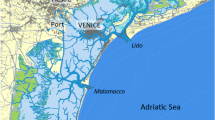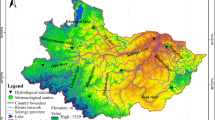Abstract
The paper focuses on the mid-term shoreline evolution and recent short-term shoreline trends of five sandy beaches located along the southeastern coast of Gran Canaria. Using the Digital Shoreline Analysis System (DSAS), shoreline changes during the period 1961–2016 and sub-periods 1961–1998, 1998–2010 and 2010–2016 were assessed. Major results highlight a mid-term shoreline retreat of the southern coast stretch (Maspalomas Beach) and shoreline advance/stability of the eastern coast stretch (El Inglés, El Veril, Las Burras and San Agustin beaches), conversely positive and negative shoreline trends of Maspalomas and the eastern beaches, respectively, during the short-term period 2010–2016. Shoreline data and wind/wave data covering the period 1958–2004 highlight for Maspalomas a probable relationship between its negative mid-term shoreline evolution and a relative major severity of wave climate along the southern coast stretch. Moreover, regarding the negative short-term shoreline trend assessed for eastern beaches, an increase of wave dynamics is hypothesized, to be investigated in the near future. For the possible influence of hard defence structures on shoreline changes, data suggest that the groins placed along El Inglés, Las Burras and El Veril beaches have positively influenced shoreline trends in a first period, but did not contribute to overall beach stabilization or progradation in later periods. Results and data acquired during this study, concerning not only shoreline changes and related rates, but also possible causal aspects, can validly support both future research on sandy beaches in southeastern Gran Canaria and management interventions aimed at the development of coastal sustainable tourism in the studied coastal area.








Similar content being viewed by others
References
Alcántara-Carrió J, Fontán A (2009) Factors controlling the morphodynamics and geomorphologic evolution of a cuspate foreland in a volcanic intraplate island (Maspalomas, Canary Islands). J Coast Res SI 56: 683–687. ISSN 0749-0208
Alonso I, Montesdeoca I, Vivares A, Alcantara-Carrio J (2001) Variabilidad granulometrica y de la linea de costa en las playas de El Ingles y Maspalomas (Gran Canaria). Geotemas 3(1):39–42
Alonso I, Alcántara-Carrió J, Cabrera L (2002) Tourist resorts and their impact on Beach Erosion at Sotavento Beaches, Fuerteventura, Spain. J Coast Res SI 36:1–7
Anfuso G, Rangel-Buitrago N, Cortés-Useche C, Iglesias CB, Gracia FJ (2016) Characterization of storm events along the Gulf of Cadiz (eastern central Atlantic Ocean). Int J Climatol 36:3690–3707
ASTM (2007) Standard test method for particle-size analysis of soils. In: Annual Book of ASTM Standards, ASTM, West Conshohocken
ASTM (2018) Standard practice for dry preparation of soil samples for particle-size analysis and determination of soil constants. https://www.astm.org/Standards/D421.htm. Accessed 1 Sept 2018
Bamunawala J, Maskey S, Duong TM, Van der Spek A (2018) Significance of fluvial sediment supply in coastline modelling at tidal inlets. J Mar Sci Eng 6(3):79. https://doi.org/10.3390/jmse6030079
Bechtel B (2016) The climate of the Canary Islands by annual cycle parameters. The international archives of the photogrammetry, remote sensing and spatial information sciences. vol XLI-B8 (2016) XXIII ISPRS Congress, 12–19 July 2016. Czech Republic, Prague
Besset M, Anthony EJ, Sabatier F (2017) River delta shoreline reworking and erosion in the Mediterranean and Black Seas: the potential roles of fluvial sediment starvation and other factors. Elem Sci Anthr 5:54. https://doi.org/10.1525/elementa.139
Boak EH, Turner IL (2005) Shoreline definition and detection: a review. J Coast Res 21:688–703
Chiri H, Pacheco M, Rodríguez G (2013) Spatial variability of wave energy resources around the Canary Islands. WIT Trans Ecol Environ 169:15–26
Crowell M, Leatherman SP, Buckley M (1993) Shoreline change rate analysis: long term versus short term data. Shore Beach 61(2):13–20
Crowell M, Douglas BC, Leatherman S (1997) On forecasting future US shoreline positions: a test of algorithms. J Coast Res 13:1245–1255
del Arco M, Salas M, Acebes JR, del Marrero MC, Reyes-Betancort JA, Péerez-de-Paz PL (2002) Bioclimatology and climatophilous vegetation of Gran Canaria (Canary Islands). Ann Bot Finnici 39:15–41
Del Río L, Gracia FJ, Benavente J (2013) Shoreline change patterns in sandy coasts. A case study in SW Spain. Geomorphology 196:252–266. https://doi.org/10.1016/j.geomorph.2012.07.027
Di Paola G, Aucelli PPC, Benassai G, Iglesias J, Rodriguez G, Rosskopf CM (2018) The assessment of the coastal vulnerability and exposure degree of Gran Canaria Island (Spain) with a focus on the coastal risk of Las Canteras Beach in Las Palmas de Gran Canaria. J Coast Conserv 22(5):1001–1015. https://doi.org/10.1007/s11852-017-0574-9
Di Paola G, Iglesias J, Rodríguez G, Benassai G, Aucelli PPC, Pappone G (2011) Estimating coastal vulnerability in a meso-tidal beach by means of quantitative and semi-quantitative methodologies. J Coast Res 61:303–308. https://doi.org/10.2112/SI61-001.1
EEA (2015) State of the Europe’s sea. EEA Report No. 2/2015. European Environment Agency, Luxembourg: Publications Office of the European Union, 2017. ISBN 978-92-9213-859-2. https://doi.org/10.2800/0466
EUROSION (2019) Living with coastal erosion in Europe: sediment and space for sustainability. Reports on-line. https://www.eurosion.org
Ferrer-Valero N, Hernández-Calvento L, Hernández-Cordero AI (2017) Human impacts quantification on the coastal landforms of Gran Canaria Island (Canary Islands). Geomorphology 286:58–67. https://doi.org/10.1016/j.geomorph.2017.02.028
Fontán A, Alcántara-Carrió J, Correa ID (2012) Combined beach-inner shelf erosion in the short and medium term (Maspalomas, Canary Islands). Geol Acta 10(4):411–426
Fontán-Bouzas A, Alcántara-Carrio J, Albarracín S, Baptista P, Silva P, Portz L, Manzolli R (2019) Multiannual Shore Morphodynamics of a Cuspate Foreland: Maspalomas (Gran Canaria, Canary Islands). J Mar Sci Eng 7:416
Gorman L, Morang A, Larson R (1998) Monitoring the coastal environment. Part IV: mapping, shoreline changes, and bathymetric analysis. J Coast Res 14:61–92
GRAFCAN (2018) Mapas de Canarias. https://www.grafcan.es/. Accessed 10 Dec 2018
Grottoli E, Bertoni D, Ciavola P (2017) Short- and medium-term response to storms on three Mediterranean coarse-grained beaches. Geomorphology 295:738–748. https://doi.org/10.1016/j.geomorph.2017.08.007
Guedes Soares C (2008) Hindcast of dynamic processes of the ocean and coastal area of Europe (HIPOCAS). Coast Eng 55:825–826
Hamm L, Capobianco M, Dette HH, Lechuga A, Spanhoff R, Stive MJF (2002) A summary of European experience with shore nourishment. Coast Eng 47:237–264
Hernández L, Alonso I, Sánchez-Pérez I, Alcántara-Carrió J, Montesdeoca I (2007) Shortage of Sediments in the Maspalomas Dune Field (Gran Canaria, Canary Islands) deduced from analysis of aerial photographs, foraminiferal content, and sediment transport trends. J Coast Res 23(4):993–999
Hinkel J, Nicholls RJ, Tol RSJ, Wang ZB, Hamilton JM, Boot G, Vafeidis AT, McFadden L, Ganopolski A, Klein RJT (2013) A global analysis of erosion of sandy beaches and sea-level rise: an application of DIVA. Glob Planet Change 111:150–158
Luijendijk A, Hagenaars G, Ranasinghe R, Baart F, Donchyts G, Aarninkhof S (2018) The state of the world’s beaches. Sci Rep 8:6641. https://doi.org/10.1038/s41598-018-24630-6
Menéndez I, Silva PG, Martín-Betancor M, Pérez-Torrado FJ, Guillou H, Scaillet S (2008) Fluvial dissection, isostatic uplift, and geomorphological evolution of volcanic islands (Gran Canaria, Canary Islands, Spain). Geomorphology 102:189–203. https://doi.org/10.1016/j.geomorph.2007.06.022
Martinez JM (1988) Accretion-erosion in the beaches of the Canary Islands (Spain). Proceedings of the international conference on coastal engineering (ASCE) 3:2738–2752
Mentaschi L, Vousdoukas MI, Pekel J, Voukouvalas E, Feyen L (2018) Global long-term observations of coastal erosion and accretion. Sci Rep 8:12876. https://doi.org/10.1038/s41598-018-30904-w
Morton ID, Bowers J, Mould G (1997) Estimating return period wave heights and wind speeds using a seasonal point process model. Coast Eng 31(1–4):305–326
Nguyen AT, Nguyen NT, Luong TT, Luc H (2018) Tourism and beach erosion: valuing the damage of beach erosion for tourism in the Hoi An World Heritage site, Vietnam. Environ Dev Sustain. https://doi.org/10.1007/s10668-018-0126-y
Nicholls RJ, Wong PP, Burket VR, Codignotto J, Hay JE, McLean RF, Ragoonaden S, Woodroffe CD (2007) Coastal systems and low-lying areas. In: Parry ML, Canziani OF, Palutikof JP, Linden PJ, Hanson CE (eds) Climate change 2007: impacts, adaptation and vulnerability. Contribution of Working Group II to the Fourth Assessment Report of the Intergovernmental Panel on Climate Change. Cambridge University Press, Cambridge, pp 315–356
Pilar P, Guades Soares C, Carretero JC (2008) 44-year wave hindcast for the east Atlantic European coast. Coast Eng 55:861–871. https://doi.org/10.1016/j.coastaleng.2008.02.027
Puig M, Del Río L, Plomaritis TA, Benavente J (2016) Contribution of storms to shoreline changes in mesotidal dissipative beaches: case study in the Gulf of Cádiz (SW Spain). Nat Hazards Earth Syst Sci 16:2543–2557. https://doi.org/10.5194/nhess-16-2543-2016
Quevedo Medina U, Hernández-Calvento L (2014) Evolución reciente de la línea de costa en un sistema playadunas deficitario (Maspalomas, Gran Canaria). XVI Congreso Nacional de Tecnologías de la Información Geográfica 2014, Alicante. 163–171. ISBN: 978-84-940784-4-6|84-940784-4-5
Rangel-Buitrago N, Anfuso G (2013) Winter wave climate, storms and regional cycles: the SW Spanish Atlantic coast. Int J Climatol 33:2142–2156
Rizzo A, Aucelli PPC, Gracia FJ, Anfuso G (2018) A novelty coastal susceptibility assessment method: application to Valdelagrana area (SW Spain). J Coast Conserv 22(5):973–987. https://doi.org/10.1007/s11852-017-0552-2
Rosskopf CM, Di Paola G, Atkinson DE, Rodríguez G, Walker IJ (2018) Recent shoreline evolution and beach erosion along the central Adriatic coast of Italy: the case of Molise region. J Coast Conserv 22(5):879–895. https://doi.org/10.1007/s11852-017-0550-4
Santana-Cordero AM, Bürgi M, Hersperger AM, Hernández-Calvento L, Monteiro-Quintana ML (2017) A century of change in coastal sedimentary landscapes in the Canary Islands (Spain): change, processes, and driving forces. Land Use Policy 68:107–116
Sheppard C (2018) World Seas: An Environmental Evaluation: Volume I: Europe, The Americas and West Africa (English Edition), Academic Press, p 912
Thieler ER, Himmelstoss EA, Zichichi JL, Ayhan E (2009) Digital Shoreline Analysis System (DSAS) version 4.0—an ArcGIS extension for calculating shoreline change: U.S. Geological Survey Open-File Report 2008-1278
Valdemoro HI, Jimènez JA (2006) The influence of shoreline dynamics on the use and exploitation of Mediterranean tourist beaches. Coast Manag 34:405–423. https://doi.org/10.1080/08920750600860324
Zhang K, Douglas BC, Leatherman SP (2004) Global warming and coastal erosion. Clim Change 64:41–58
Author information
Authors and Affiliations
Corresponding author
Additional information
Publisher's Note
Springer Nature remains neutral with regard to jurisdictional claims in published maps and institutional affiliations.
Rights and permissions
About this article
Cite this article
Di Paola, G., Rodríguez, G. & Rosskopf, C.M. Short- to mid-term shoreline changes along the southeastern coast of Gran Canaria Island (Spain). Rend. Fis. Acc. Lincei 31, 89–102 (2020). https://doi.org/10.1007/s12210-020-00872-3
Received:
Accepted:
Published:
Issue Date:
DOI: https://doi.org/10.1007/s12210-020-00872-3




